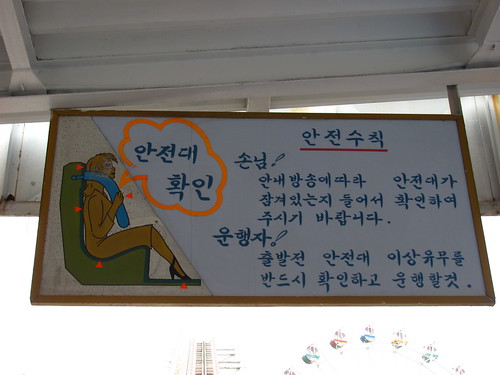Gwangjin-gu, Seoul, South Korea – Wednesday, June 8th, 2011
Children’s Grand Park is a small amusement park—amusement plaza, more like it—within a larger public park complex near the heart of Seoul. Seoul Children’s Grand Park is not to be confused with Seoul Grand Park, which is where the much larger Seoul Land amusement park I just came from is located, and is not located directly in Seoul. Given the timing of the metro only have about a half hour to see this small park before I’d have to move on to my final and most important stop of the day, Lotte World. But first, I’d have to find it. Unlike some similarly large public parks with amusement areas in China, Children’s Grand Park at least offered a map and fairly clear layout to make finding it quite easy.
This large steam locomotive was on display near the park. Apparently it dates from the early 1950’s.
Despite being a rather dumpy amusement area, Children’s Grand Park was made globally famous a year after my visit when its carousel featured in PSY’s Gangnam Style music video. I didn’t get a picture of the carousel. Shortly after its rise to fame, the park was almost entirely rebuilt, replacing the coasters found on this visit with a new Vekoma Suspended Family Coaster in 2014. Probably a better choice than a triple-looping coaster for a park named for children, although what I experienced in 2011 was undoubtedly weirder.
One of the two coasters I was expecting to ride, the Interpark made Crazy Mouse, would not be open today.
The steep lift hill and unconventional compact layout with a seemingly freeform lateral switchback pattern would have been interesting to experience. After it was taken down in 2018, I believe there is only one type of this coaster left traveling the European fair circuit.
The design of this children’s car ride confused me to no end.
Here’s an interesting find: a train from the first roller coaster built at Children’s Grand Park… indeed, the first roller coaster built in all of South Korea, back in 1973 as the Blue Dragon Train. It appears as though they’ve kept this artifact on display at the new Children’s Grand Park, now accompanied by cars from my next (and only) ride.
I only bought tickets for one ride on the 88 Train, the park’s largest attraction and only operating roller coaster.
88 Train was built in 1984 by Meisho Amusement Machines of Japan, replacing the Blue Dragon Train. It would permanently close less than a year after my visit.
“88” is considered a lucky number in Chinese since the word for eight sounds similar to the word for wealth. I’m not sure the significance of the number for naming a coaster made by Koreans and Japanese people.
The ride layout loosely takes after the traditional Arrow Dynamics loop-corkscrew design. Apart from the inversions, the engineers appeared uncertain how to pitch the track for high-banked turns or steeper incline angles, so the rest of the layout makes accommodations to the Arrow formula to be more broad and ramp-like.
This relatively steep incline after the loop (leading to a sharp crest of airtime) being one exception to an otherwise conservative design.
A second red train sits out of commission for today, and quite possibly forever.
A delightfully homemade robot greets riders to the queue.
Peeled paint layers on the handrails reveal the variety of color schemes the coaster’s station has had over the years, an effect not entirely dissimilar to Fordite.
Ready to climb aboard. I’d be the only one riding.
The low-slung cars came with precious little legroom. A simple gate clip provides the redundant safety feature.
And I’m ready to ride. I captured my full ride on video, a far more comfortable way to experience it.
One and done. All considered, it’s still a pretty significant coaster for a one-stop credit at a children’s park. Onward and upward to my third and final (and largest) park of the day.

































Comments